Subaru Outback (BR): Pre-delivery Inspection
A: GENERAL DESCRIPTION
The purposes of the pre-delivery inspection (PDI) are as follows.
- Remove the additional parts used for ensuring the vehicle quality during transportation and restore the vehicle to its normal condition.
- Check the vehicle before delivery is in normal condition.
- Check the vehicle has no damage and no vehicle protective parts are missing while shipped or stored in a car barn.
- Make sure to deliver a complete vehicle to customer.
For above reasons, all SOA service center must carry out the PDIs before delivery of vehicle.
Besides, all SOA service center and PDI center check the condition of all vehicles to make sure to take responsibility.
B: PRE-DELIVERY INSPECTION (PDI) PROCEDURE
Static Checks Just after Vehicle Receipt
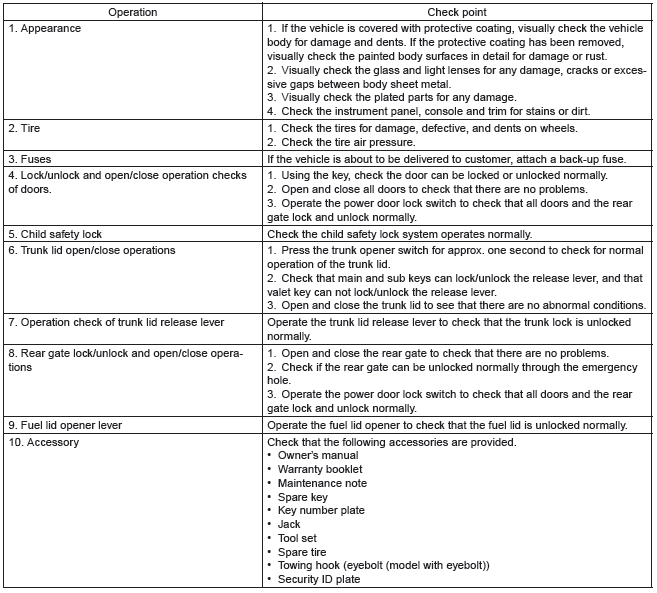
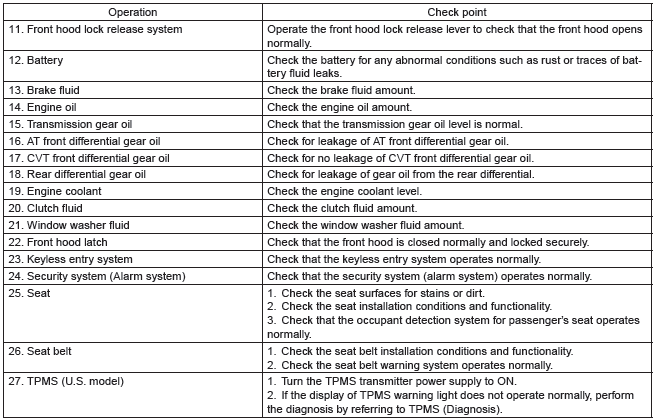
Checks with the Engine Running
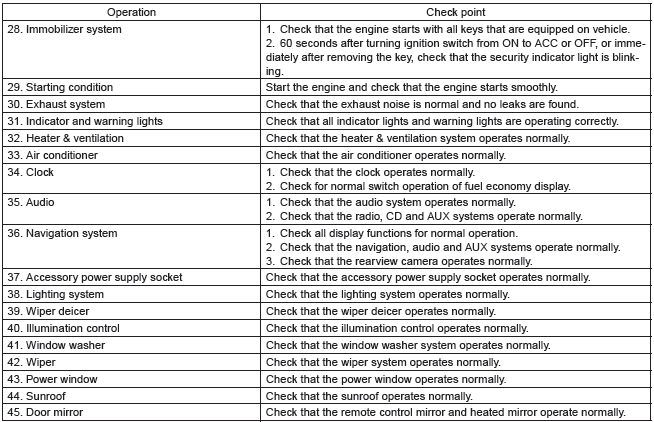

Dynamic Test with the Vehicle Running

Checks after Dynamic Test

1. APPEARANCE
- If the vehicle is covered with protective coating, visually check the vehicle body for damage and dents.
- When the protective coating is removed, visually check the body paints for damage or stains in detail and repair as necessary.
- Visually check the windshield glass, door glasses and light lenses for any damage, cracks or excessive gaps to the body sheet metal and repair as necessary.
- Visually check the plated parts, such as the grilles and door knobs, for damage or loss of gloss and replace the parts as necessary.
- Check the instrument panel, console, and trims for stains or dirt.
2. TIRE
- Check the tires for damage, defective, and dents on wheels.
- Check and correct the tire size, spare tire and tire air pressure described on the tire air pressure label (driver's side).
3. FUSE
Right after the vehicle has arrived, 10A backup fuse is removed to avoid run-down of the battery.
Connect the backup fuse as shown in the figure. Also, delivery mode is canceled by disconnecting the backup fuse from the fuse holder.
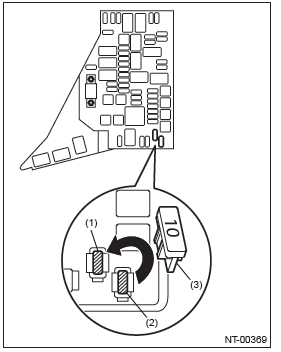
- Backup fuse insertion slot
- Backup fuse holder
- Backup fuse
4. LOCK/UNLOCK AND OPEN/CLOSE OPERATION CHECKS OF DOORS
1) Using the key, lock and unlock the door several times to check for normal operation. Open and close the door several times for smooth movement.
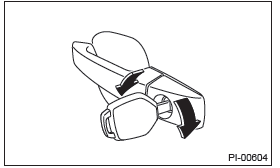
2) Completely close the driver's door, and then check the smooth movement with operating door lock knob from lock to unlock several times. Set the door lock knob (A) to lock position. Then pull the inner remote (B) to ensure that doors will not open.
For other doors, place the door lock knob (A) to lock position and then pull the inner remote (B) to ensure that doors will not open.
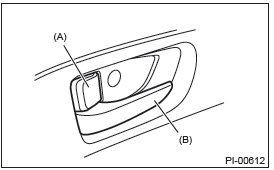
- Door lock knob
- Inner remote
3) Close all the doors, and then press the lock on power door lock switch at driver's side. Check that all doors including rear gate are locked.
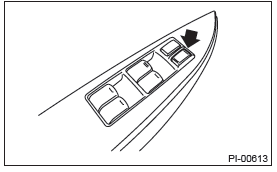
4) Press the driver's side power door lock switch to unlock side. Check that all doors including rear gate are unlocked.
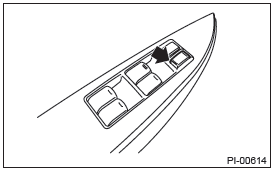
5) Check that the passenger's side power door lock switch locks and unlocks normally in the same manner.
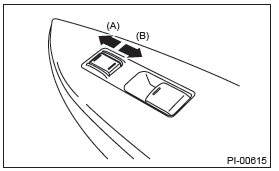
- Lock
- Unlock
6) Insert the key to ignition switch, and open the driver's side door. Press lock on power door lock.
Check that the door is not locked.
5. CHILD SAFETY LOCK SYSTEM
1) Set the child safety lock on both rear doors to the lock position.
2) Close the rear doors completely.
3) Check that the lock levers of the rear doors are in the unlock position. Then, pull inner remote of rear doors to ensure that the doors will not open.
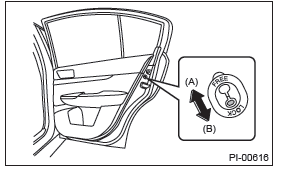
- Lock
- Unlock
4) Pull the outer handles to ensure that doors will open.
6. OPEN/CLOSE OPERATION CHECKS OF TRUNK LID
1) Press the trunk opener switch for approx. one second to check for normal operation of the trunk lid.
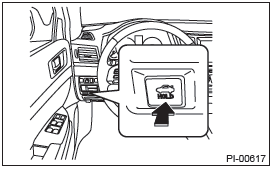
2) Open and close the trunk lid several times for smooth movement.
3) Press the trunk opener lock button in the glove box.
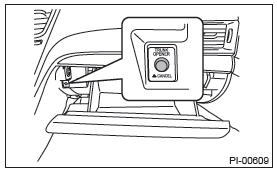
4) Check that the trunk lid will not open even when the trunk opener button is pressed.
7. TRUNK LID RELEASE HANDLE
CAUTION: Do not check the trunk lid release handle when in the trunk. If the trunk lid release handle is defective, you may be trapped in.
1) Use a flat tip screwdriver. Slide in the screwdriver through the clearance at the lock assembly until a click sound is heard. This is the latch lock position.
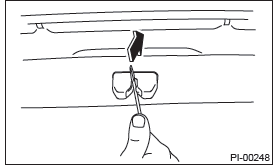
2) Make sure the latch is released by pulling the yellow trunk lid release handle in the direction of arrow.
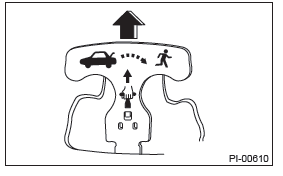
8. LOCK/UNLOCK AND OPEN/CLOSE OPERATIONS OF REAR GATE
1) Open and close the rear gate several times for smooth movement.
2) Operate the rear gate lever to check that the rear gate is locked and unlocked normally.
- Remove the cover inside the rear gate.
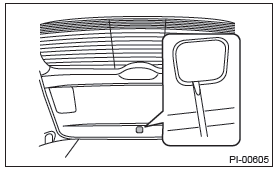
- Operate the lever to check that the rear gate is locked and unlocked normally.
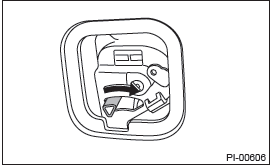
9. FUEL LID OPENER LEVER
Operate the fuel lid opener to check that the fuel lid is unlocked normally. Check that the filler cap is securely closed.
10. ACCESSORY
Check that the following accessories are provided.
- Owner's manual
- Warranty booklet
- Maintenance note
- Spare key
- Key number plate
- Jack
- Tool set
- Spare tire
- Towing hook (eyebolt (model with eyebolt) )
- Security ID plate
- Sedan model
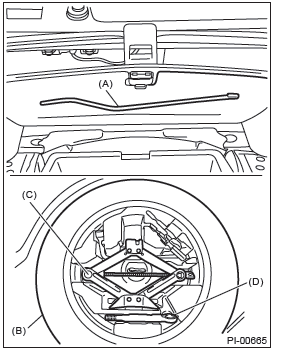
- Jack handle
- Spare tire
- Jack
- Towing hook (eyebolt)
- Wagon model
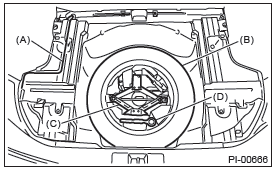
- Jack handle
- Spare tire
- Jack
- Towing hook (eyebolt)
11. OPERATION CHECK OF FRONT HOOD LOCK RELEASE SYSTEM
Operate the front hood lock release lever (A) to check that the front hood is unlocked normally.
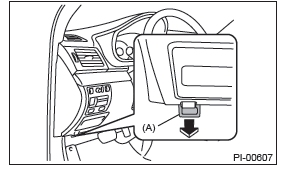
Operate the lever (B) and check that the front hood is opened normally. Check that the front hood can be supported by damper stay.
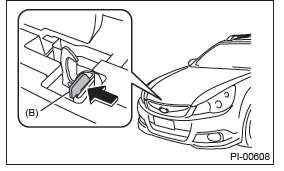
12. BATTERY
Check the battery terminals to make sure that there are no rust or corrosions due to fluid leaks.
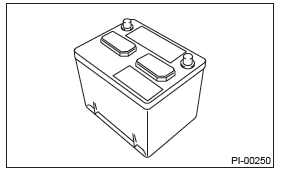
13. BRAKE FLUID
CAUTION: If the brake fluid is spilt over exhaust pipe, wipe it off with cloth to avoid emitting smoke or causing a fire.
Check that the brake fluid level is normal. If the amount is insufficient, carry out a brake line test to identify brake fluid leaks and check the brake operation.
After that, refill the brake fluid tank with the specified type of fluid.
14. ENGINE OIL
CAUTION: If engine oil is spilt onto the exhaust pipe, wipe it off with cloth to avoid emission of smoke or causing a fire.
Check the engine oil amount. If the amount of oil is insufficient, check that no leaks are found. Then, add the necessary amount of the specified engine oil.
- 2.5 L model
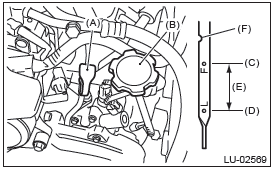
- Oil level gauge
- Engine oil filler cap
- "F" line
- "L" line
- Approx. 1.0
 (1.1 US qt, 0.9 Imp qt)
(1.1 US qt, 0.9 Imp qt) - Notch mark
- 3.6 L model
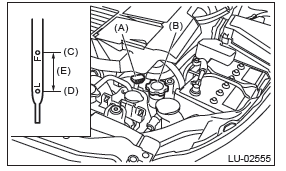
- Oil level gauge
- Engine oil filler cap
- "F" line
- "L" line
- Approx. 1.0
 (1.1 US qt, 0.9 Imp qt)
(1.1 US qt, 0.9 Imp qt)
15. TRANSMISSION GEAR OIL
CAUTION: If transmission gear oil is spilt over the exhaust pipe, wipe it off with a cloth to avoid emitting smoke or causing a fire.
Check that the transmission gear oil level is normal.
If the amount of gear oil is insufficient, check that no leaks are found. Then add the necessary amount of the specified transmission gear oil.
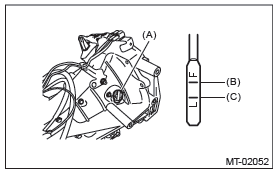
- Oil level gauge
- Upper level
- Lower level
16. AT FRONT DIFFERENTIAL GEAR OIL
CAUTION: If the differential gear oil is spilt over exhaust pipe, wipe it off with cloth to avoid emitting smoke or causing a fire.
Check that the AT front differential gear oil level is normal. If the amount of oil is insufficient, check that no leaks are found. Then, add the necessary amount of the specified AT front differential gear oil.
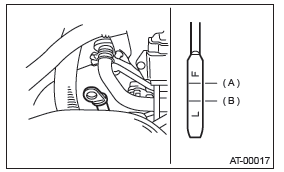
- Upper level
- Lower level
17. CVT FRONT DIFFERENTIAL GEAR OIL
CAUTION: If the front differential gear oil is spilt over exhaust pipe, wipe it off with cloth to avoid emitting smoke or causing a fire.
Check for no leakage of CVT front differential gear oil.
18. REAR DIFFERENTIAL GEAR OIL
CAUTION: If the rear differential gear oil is spilt over exhaust pipe, wipe it off with cloth to avoid emitting smoke or causing a fire.
Check for leakage of gear oil from the rear differential.
19. ENGINE COOLANT
CAUTION: If the engine coolant is spilt over exhaust pipe, wipe it off with cloth to avoid emitting smoke or causing a fire.
Check that the engine coolant level on the reservoir tank is normal. If the amount of engine coolant is insufficient, check that no leaks are found. Then, add the necessary amount of coolant with the specified concentration.
20. CLUTCH FLUID
CAUTION: If the clutch fluid is spilt over the exhaust pipe, wipe it off with cloth to avoid emitting smoke or causing a fire.
Check that the clutch fluid level is normal. If the amount of the fluid is insufficient, check that no leaks are found. Then, add the necessary amount of the specified fluid.
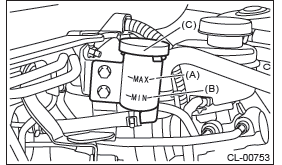
- MAX. level
- MIN. level
- Reservoir tank
21. WINDOW WASHER FLUID
Check that the window washer fluid level is normal.
If the amount is insufficient, check that no leaks are found. Then, add the necessary amount of washer fluid.
22. FRONT HOOD LATCH
Close the front hood. Check that the front hood is securely latched.
23. KEYLESS ENTRY SYSTEM
NOTE: The following inspections show the initial settings.
When the settings are different from the initial settings, use Subaru Select Monitor to check the details of each setting for inspections.
1) Fully open all the door windows.
2) Remove the key from the ignition switch and close all the doors including rear gate.
3) Press the rear gate and trunk open button for at least one second.
- Check if the trunk is opened and the hazard light blinks twice and the buzzer sounds twice. (Sedan model)
- Check if the rear gate is unlocked and the hazard
light blinks twice and the buzzer sounds twice.
(OUTBACK model)
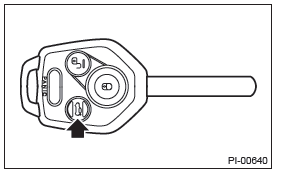
4) Press the "LOCK" button on the keyless transmitter with one of the doors (including the rear gate and trunk) opened. Check if all doors are locked, hazard light blinks five times and the buzzer sounds five times and warning shows one of the doors (including the rear gate and trunk) open.
5) Close all the doors including rear gate and trunk.
Press the "LOCK" button momentarily on the keyless transmitter. Check that all the doors (including rear gate and trunk) are locked, hazard light blinks once and buzzer sounds once.
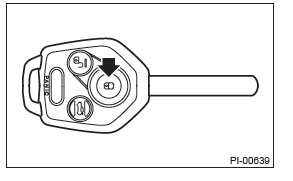
6) Press the "UNLOCK" button momentarily on the keyless transmitter. Check that the driver's door is unlocked and hazard light blinks twice and the buzzer sounds twice.
And press the "UNLOCK" button momentarily again in 5 seconds. Check that all doors (including rear gate) are unlocked.
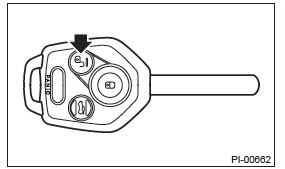
7) Within a distance of 10 m from a vehicle, press keyless transmitter's "LOCK" button three times within five seconds. Check that the horn honks once and that the hazard light blinks three times.
8) Move the power door lock switch to the lock position with one of doors (including the rear gate) opened. Next, close all the doors including rear gate. Check if all doors are locked and buzzer sounds once and the hazard light flashes once.
9) Check buzzer operation.
The buzzer sounds when the doors are locked or unlocked. The buzzer can be turned off if desired.
Turn the buzzer off or on with following procedure.
- Close all the doors including rear gate, then remove the key from ignition key lock.
- Press the power door lock switch to unlock and hold it until the operation is finished.
- Insert the key into ignition key lock, and insert and remove the key in ignition key lock 5 times in 10 seconds.
- When finished step (3), open and close the driver's door once within 10 seconds.
NOTE: When opening and closing of the door is not available within 10 seconds, hazard light blinks once and the change over operation is cancelled. Retry from the step (1).
- Hazard light blinks 3 times and the buzzer sound turns ON or OFF.
10) Press the "PANIC" button of the keyless transmitter.
Check if the alarm condition happens (horn sounds continuously, hazard light blinks, security indicator comes on). Check whether this condition lasts until any button on the keyless transmitter is pressed or lasts for 30 seconds.
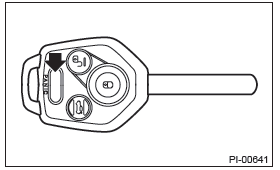
24. SECURITY SYSTEM (ALARM SYSTEM)
NOTE: The following inspections show the initial settings.
When the settings are different from the initial settings, use Subaru Select Monitor to check the details of each setting for inspections.
1) Fully open all the door windows.
2) Remove the key from the ignition switch and close all the doors including rear gate.
3) Press the "LOCK" button momentarily on the keyless transmitter. All doors are locked, and buzzer sounds once, hazard blinks once, security indicator light blinks faster (five times per two seconds) for 30 seconds and goes slower (twice per two seconds), then the alarm system is in set condition.
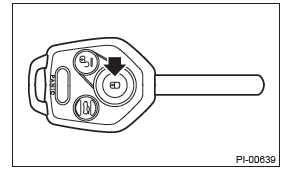
4) Press the "UNLOCK" button momentarily on the keyless transmitter. When the door of the driver's seat is unlocked, the buzzer sounds twice, the hazard light flashes twice, the room light turns on and the security indicator light flashes once in three seconds, and the alarm system enters the release mode.
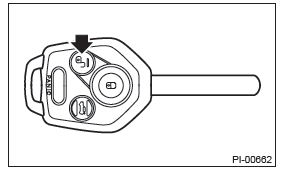
5) Close all the doors including rear gate. Press the "LOCK" button momentarily on the keyless transmitter.
When all the doors are locked, buzzer sounds once, hazard blinks once and the alarm system is in set condition in 30 seconds.
6) Unlock the door using the inner lock knob and open the door while the alarm system is in the set mode. Check if the alarm condition happens (horn sounds continuously, hazard light blinks, security indicator illuminates). Check if this condition lasts for a maximum of three minutes or until the "UNLOCK" button of the keyless transmitter is pressed.
NOTE: The alarm condition will cease in 30 seconds once the door is closed.
7) When none of above is applicable, perform troubleshooting for the security system.
25. SEAT
1) Check the seat surfaces for stains or dirt.
2) Check that each seat provides full functionality in sliding and reclining. Check all available functions of the rear seat such as a trunk-through and center armrest.
3) Check the passenger's seat occupant detection system.
- Turn the ignition switch to ON.
- Check the ON and OFF of passenger's airbag indicator light come on simultaneously for about 6 seconds and go off for 2 seconds, and then only OFF illuminates again.
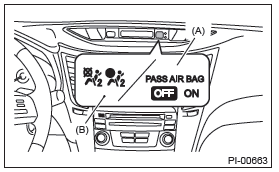
- Indication for US
- Indication for Canada
- Have a person weighing approximately 70 kg (155 lb) or more sit in the passenger's seat, and check whether the passenger's airbag indicator light illuminate or not.
- Empty the passenger seat, then check whether the passenger side airbag indicator light OFF illuminates.
26. SEAT BELT
1) Check installation condition of seat belt.
2) Pull out the seat belt and then release it. Check that the belt retracts smoothly.
3) Check that the ALR seat belt operates normally.
4) Check seat belt warning function.
- Turn the ignition switch to ON with the driver's and passenger's seat belt detached.
- Check the driver's and passenger's seat belt warning light blink for approx. 6 seconds and the buzzer sounds intermittently.
- Then, check the seat belt warning light illuminates and blinks repeatedly at a cycle of approx. 15 seconds. (If no passenger is on the passenger's seat, the seat belt warning light on passenger's seat does not operate.)
- When the driver's seat belt is fastened, check that the driver's seat belt warning light turns off.
- When the passenger's seat belt is fastened, check that the passenger's seat belt warning light turns off. (If no passenger is on the passenger's seat, the seat belt warning light on passenger's seat does not operate.)
27. TPMS
1) Turn the ignition switch to ON, and check TPMS warning light for normal operation.
- Normal operation (IG ON (light check) )
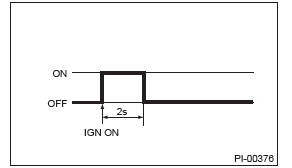
2) If the TPMS warning light display does not operate normally, check and repair the system.
28. IMMOBILIZER SYSTEM
1) Check that the engine starts with all keys that are equipped on vehicle.
2) 60 seconds after turning ignition switch from ON to ACC or OFF, or immediately after removing the key, check that the security indicator light is blinking.
3) For the model for Canada, execute Each System Check > Integ. unit mode > "SCU collation mode" on SSMIII to check [Collation OK (no error) ] is displayed.
NOTE: If malfunctions occur, refer to "IMMOBILIZER (DIAGNOSIS)".
29. STARTING CONDITION
Start the engine and check that the engine starts smoothly. If the battery voltage is low, recharge or replace the battery. If any noises are observed, immediately stop the engine and check and repair the abnormal components.
30. EXHAUST SYSTEM
Listen to the exhaust noise to see if no exhaust gas leak or abnormal noises are observed.
31. INDICATOR LIGHT AND WARNING LIGHT
Check that all indicator lights and warning lights operate normally.
32. HEATER & VENTILATION
Operate the heater & ventilation system to check for normal airflow outlet control, air inlet control, airflow capacity and heating performance.
33. AIR CONDITIONER
Operate the air conditioner. Check that the A/C compressor operates normally and enough cooling is provided.
NOTE: To prevent the insufficient lubrication of the air conditioner, operate the air conditioner for five minutes at idling.
34. CLOCK
Check the clock for normal operations and enough accuracy. Check the fuel economy display switches by operating the knob on the meter. Also check there is no significant error on the outside temperature display.
35. AUDIO
Check that all radio functions operate, the speakers emit sound properly and the noise is at an acceptable level. Also check the CD unit and AUX unit operations.
36. NAVIGATION SYSTEM
1) Check all display functions for normal operation.
(Refer to the owner's manual for the operation procedures.)
2) Check the map disc (DVD) are provided on vehicle.
3) Check that the navigation system operates normally.
4) Check that the rearview camera operates normally.
37. ACCESSORY POWER SUPPLY SOCKET
1) Check the operation of the front accessory power supply socket.
2) Check operation of the accessory power supply socket in console box.
38. LIGHTING SYSTEM
1) Check the headlight operation.
2) Check the stop light operation.
3) Check other lights for normal operations.
39. WIPER DEICER
Check that the wiper deicer operates normally.
NOTE: When an ambient temperature is 5ºC or more, wiper deicer operation is cancelled. Press the switch for 3 seconds or more to perform the compulsory operation.
40. ILLUMINATION CONTROL
Check that the illumination control operates normally.
41. WINDOW WASHER
Check that the window washer system injects washer fluid to the specified area of the windshield and rear window glass shown in the figure.
Front injection position:
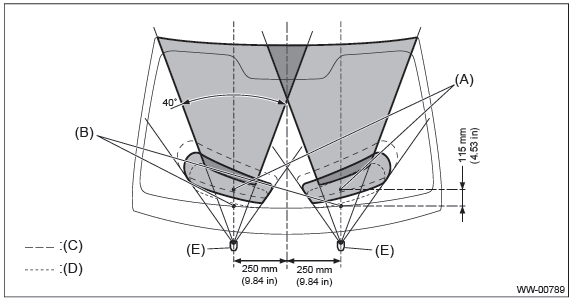
- Lower-side spray position center
- Ceramic line position on the washer nozzle center
- Washer nozzle elevation angle, lower limit of spray area
- Washer nozzle elevation angle, upper limit of spray area
- Washer nozzle
Rear injection position:
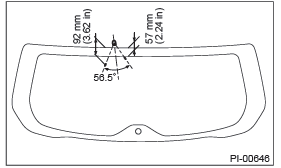
42. WIPER
Check the front and rear wipers for normal operations.
43. POWER WINDOW
- Operate the power window switches one by one to check that each of the power windows goes up and down without noises.
- Check AUTO UP/AUTO DOWN operate properly by operating the power window switch on driver's seat side.
CAUTION: If battery has been removed, AUTO UP does not operate properly because initialized. In this case, perform the initial setting (reset A) and check AUTO UP operates properly.
44. SUNROOF
Check that the sunroof operates normally.
45. DOOR MIRROR
Check that the remote control mirror and heated mirror operate normally.
46. ROOM MIRROR (RCD MODEL)
1) Check all display functions for normal operation.
2) Check that the automatic anti-glare function operates normally.
3) Check that the compass function operates normally.
4) Check that the rearview camera operates normally.
5) Perform compass calibration.
6) Perform compass zone setting.
47. REAR DEFOGGER
Check that the rear defogger system operates normally.
48. PARKING BRAKE
Check the parking brake operates properly by depressing brake pedal and pressing the electronic parking brake switch.
49. BRAKE TEST
Check the foot brake for normal operations.
50. AT, CVT SHIFT CONTROL
1) Turn the ignition switch to ON.
2) While brake pedal is not depressed, check if the select lever does not move from "P" range.
3) While brake pedal is depressed, check if the select lever moves from "P" range.
4) Set the select lever to other than "P" range.
5) When the ignition switch is turned to OFF, check if the ignition key switch cannot be removed.
6) Set the selector lever to "D" range and check the shifting while driving the vehicle.
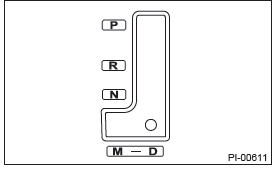
51. MT SHIFT CONTROL
1) Check for smooth operation to each position. Especially, shifting to 5th ←→ 6th, and then to Rev, check for any drag.
2) Check the slider returns to the original position by shifting to the Rev and then back in neutral while pulling up the slider.
3) If the shifting operation is not smooth, readjustment the exposed length (a) of MT gear select cable following the figure.
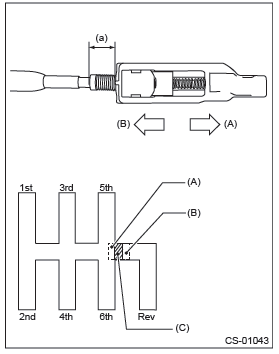
- Exposed length of MT gear select cable
- Extend direction of exposed length of MT gear select cable
- Shorten direction of exposed length of MT gear select cable
- Specification of exposed length (a)
- If the shift cannot be inserted to push the reverse
lock bracket 5th and 6th.
→ Extend the exposed length (a) of MT gear select cable.
- When operate the select lever to 4th → 5th, it
cannot be operated at select lever crank line.
→ Shorten the exposed length (a) of MT gear select cable.
52. CRUISE CONTROL
Operate the cruise control system. Check that the system is activated and deactivated correctly.
53. ATF LEVEL
CAUTION: If the ATF is spilt over exhaust pipe, wipe it off with cloth to avoid emitting smoke or causing a fire.
After selecting all positions (P, R, N, D), set the select lever in "P" range. Idle the engine for 1 or 2 minutes, and measure the ATF level. If the amount is insufficient, check that no leaks are found. Then, add the necessary amount of the specified ATF.
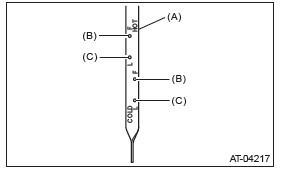
- Level gauge
- Upper level
- Lower level
54. POWER STEERING FLUID LEVEL
CAUTION: If any power steering fluid is spilt over the exhaust pipe, wipe it off with a cloth to avoid emitting smoke or causing a fire.
Check that the power steering fluid level is normal.
If the amount is insufficient, check that no leaks are found. Then add the necessary amount of the specified power steering fluid.
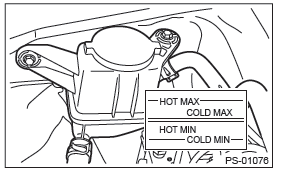
55. OIL LEAKAGE
Check entire areas of the vehicle for any trace of coolant/oil (such as engine and gear oil)/fluid (such as transmission and brake) leaks.
56. WATER LEAK TEST
Spray the vehicle with water using a hose and check that no water enters the passenger compartment.
- Before performing the water leakage test, remove anything that may obstruct the operation or which must be kept dry.
- Close all the windows and doors securely. Close the hood and trunk lid before starting the test.
- Spray the vehicle with water using a hose. The
rate of water spray must be approx. 20 to 25
 (5.3 - 6.6 US gal, 4.4 - 5.5 Imp gal) per minute.
(5.3 - 6.6 US gal, 4.4 - 5.5 Imp gal) per minute.When spraying water on areas adjacent to the floor and wheel house, increase the pressure. When spraying water on areas other than the floor and wheel house, decrease the pressure. But the force of water must be made strong occasionally by pressing the end of the hose.
NOTE: Be sure to keep the hose at least 10 cm (3.9 in) away from vehicle.
Check the following areas.
- Front window and body framework mating portion
- Door mating portions
- Glass mating portions
- Rear quarter window mating portions
- Rear window and body framework mating portion
- Around roof drips
If any dampness in the compartments is discovered after the water has been applied, carefully check all the areas that may have possibly contributed to the leak.
57. APPEARANCE CHECK 2
1) If protective coating (lap guard) is applied, remove it.
NOTE:
- It is easier to remove the wrap guard using steam.
- For a vehicle left for a long time or at low temperature, sprinkle some water heated to 50 - 60ºC (122 - 140ºF) over the vehicle to raise its surface temperature before peeling off the wrap guard. Do not use the water heated to over 60ºC (140ºF).
- If the adhesive remains exist on the coated surface, soak a flannel rag, etc. with a small amount of coating wax or solvent such as oil benzene and IPA, put the soaked cloth on the remains lightly, and then wipe them off with a flannel rag etc.
- Keep solvent from touching the resin or rubber parts. Do not use coating wax or solvent while the component surface temperature is high due to hot weather etc.
- If the coated surface is swollen out due to seams or moisture, expose the vehicle to the sunlight for a few hours or heat the seam and swollen portions using a dryer etc.
- Dispose of the peeled wrap guard as burnable industrial garbage.
- If a yellow label is attached to the fog light lens, remove it.
2) Check the whole vehicle body for flaking paint, damage by transportation, corrosion, dirt, cracks or blisters.
NOTE:
- It is better to determine an inspection pattern in order to avoid missing an area, since the total inspection area is wide.
- Do not repair the body paint unless absolutely necessary. Also, if the vehicle is in need of repair to remove scratches or corroded paint, the repair area must be limited to the minimum. Re-painting and spray painting must be avoided as much as possible.
3) Check each window glass for scratches carefully.
Slight damage may be removed by polishing with cerium oxide. (Fill a cup half with cerium oxide, and add warm water to it. Then agitate the content until it turns to wax. Apply this wax to a soft cloth, and polish the glass with it.) 4) Check each portion of the vehicle body and underside components for the formation of rust. If rust is discovered, remove it with sandpaper of #80 to #180 and treat the surface with rust preventive. After this treatment is completed, flush the portion thoroughly, and prepare the surface for repair painting.
5) Check each portion of body and all of the exterior parts for deformation or distortion. Also, check each light lens for cracks.
6) Peel the protective tape, vinyl wrapping and identification seal attached to the following places.
- Seat
- Door trim
- Floor carpet
- Side sill
- Front hood lock release lever
- Edge rear
- Rear wiper
- Sedan rear combination light (Trunk lid opening portion)
- Roof rail
- Assist rail
- Door mirror (except for North America)

